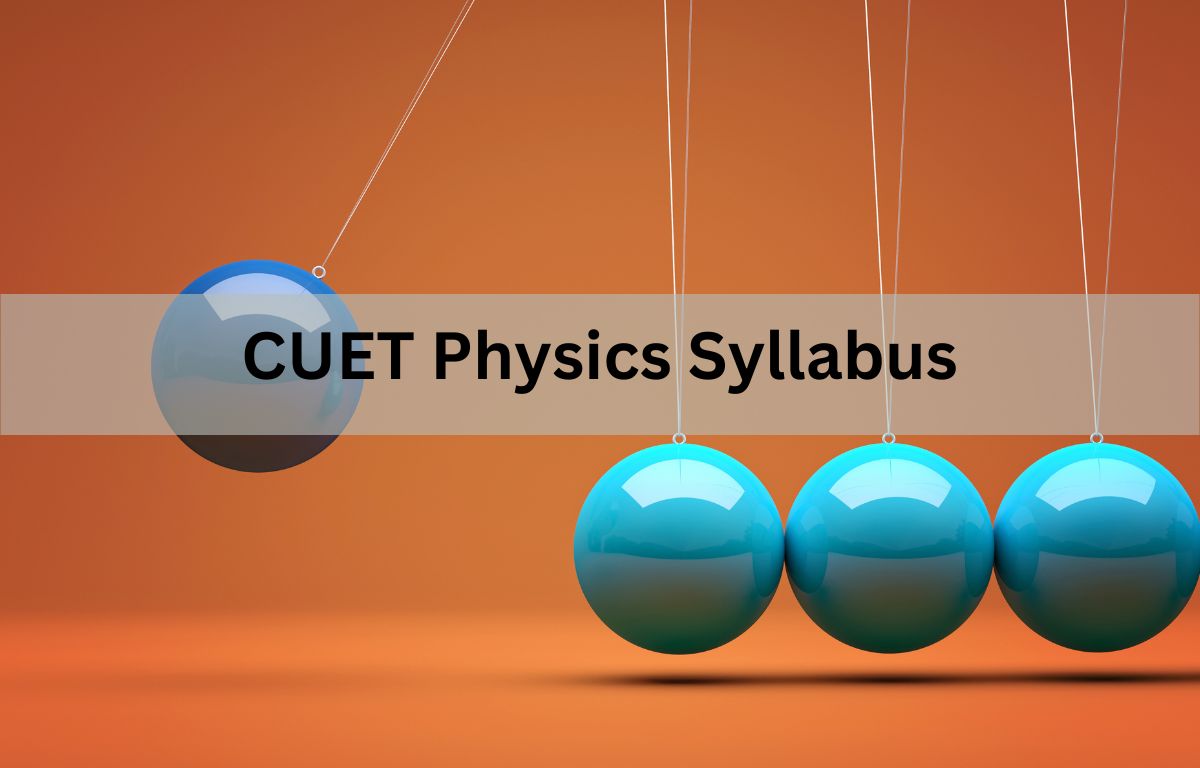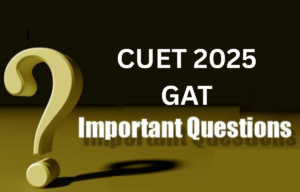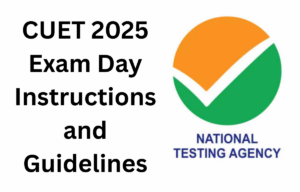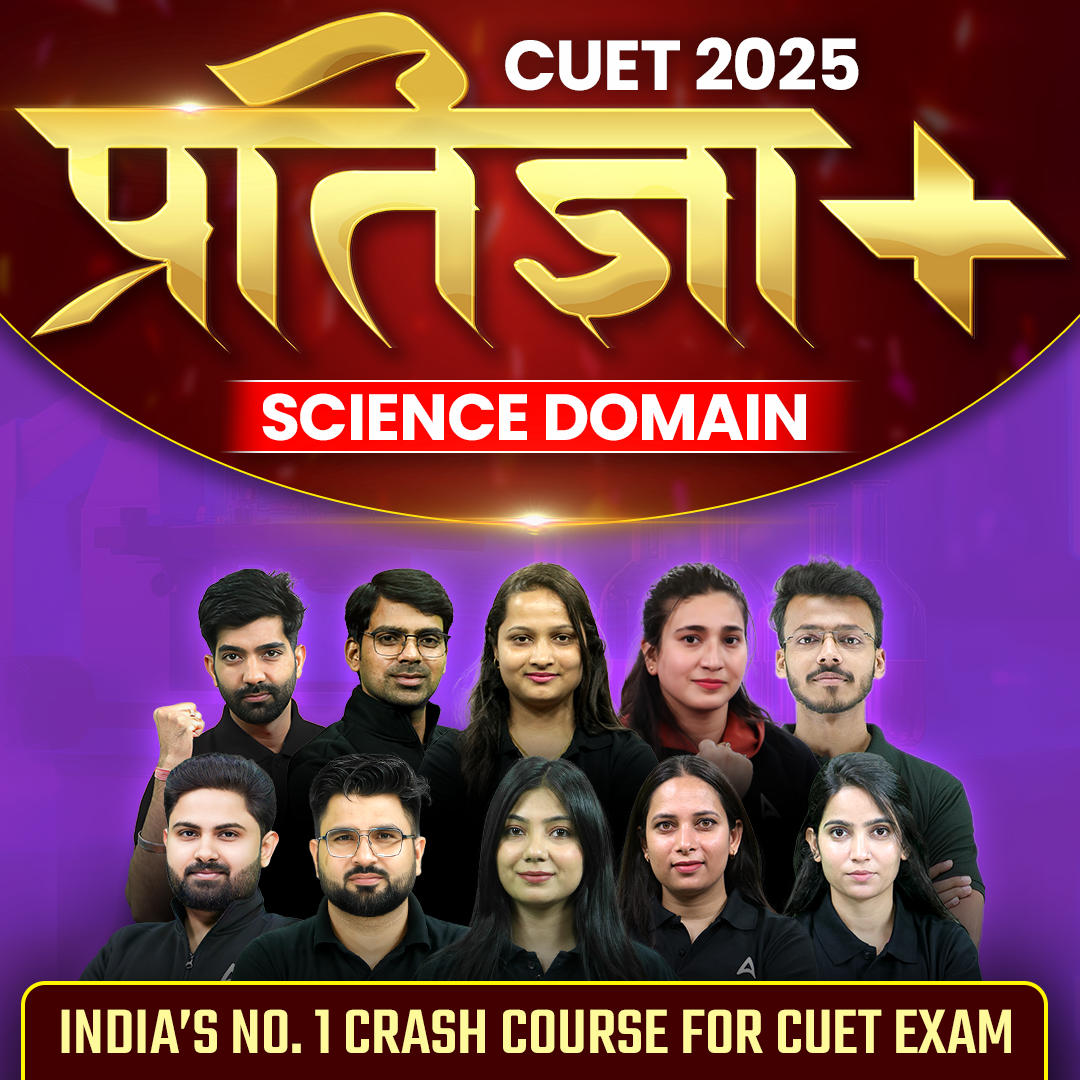Table of Contents
CUET Physics Syllabus 2025: All the students who are appearing in the Class 12 examination or have completed them and are preparing hard for their graduation-level studies must now start preparing for the CUET Exam 2025. The NTA has announced the conduction of the CUET UG Exam 2025 between May 08 and June 01, 2025 making it short for the students to complete their preparation.
Hence, all the aspirants must now rush and start solving all the algorithms and complex theorems mentioned in the CUET Physics Syllabus 2025 released by the National Testing Agency on its official website. To help students get their CUET Syllabus 2025 for Physics Exam, the direct link is added below in the article.
CUET Physics Exam 2025
The CUET Physics Exam 2025 has 50 questions, but students need to answer only 40. The exam lasts 45 minutes. It covers topics like electrostatics, electricity, magnetism, electromagnetic waves, and alternating currents. Most questions are multiple-choice, where students pick the right option. Some questions need simple calculations.
All questions have equal marks, but wrong answers reduce your score. This exam is important for students who want to study B.Tech, B.Sc. in Physics, or integrated M.Sc. programs. Universities use this exam to check if students qualify for these courses. To score well, students must prepare properly. Understanding concepts and practicing questions will help them perform better in the exam.
CUET Physics Syllabus 2025
Physics is a branch of science that studies nature and how matter and energy behave. Long ago, it was called natural philosophy, but by the late 18th century, it got its name. In the 19th century, physics became a separate subject from philosophy and other sciences. It covers many topics like how objects move (mechanics), heat, light, sound, electricity, magnetism, and the structure of atoms. The subject helps us understand how the world works. For students taking the CUET Physics exam in 2025, the syllabus includes all the important topics. This makes it easier to focus on what will be tested.
CUET Physics UG Syllabus – Topics
For clearer insights into the CUET UG exam, candidates are advised to refer to the previous years’ question papers to know the chapter-wise weightage, topics, and question types. It helps us understand how things work, from the smallest particles to the largest galaxies, making it an important part of science.
- Measurement
- Motion in one dimension
- Electrostatics
- Current Electricity
- Magnetic Effect of Current
- Matter
- Electromagnetic induction
- Ray Optics and optical instruments
- Wave Optics
- Modern Physics
- Motion in two dimensions
- Work, Power, and Energy
- Linear Momentum and collisions
- Rotation of a rigid body about a fixed axis
- Gravitation
- Oscillatory motion
- Mechanics of solids and fluids
- Heat and thermodynamics
- Wave
- Laws of Motion
CUET 2025 Unit Wise Physics Syllabus
The CUET UG Physics syllabus is split into units, each covering a different part of physics. For example, one unit is about mechanics, where you learn about motion, forces, and energy. Another unit focuses on electricity and magnetism, teaching about electric circuits and magnetic fields.
Other units may explore heat, thermodynamics, waves, and optics, which deal with light and sound. There are also units on modern physics, including topics like atoms and nuclei. The CUET Syllabus ensures that students get a broad understanding of fundamental physics concepts, preparing them for further studies.
Unit I: Electrostatics
- Electric charges and their conservation. Coulomb’s law – force between two point charges, forces between multiple charges; superposition principle, and continuous charge distribution.
- Electric field, electric field due to a point charge, electric field lines; electric dipole, electric field due to a dipole; torque on a dipole in a uniform electric field.
- Electric flux, statement of Gauss’s theorem and its applications to find field due to infinitely long straight wire, uniformly charged infinite plane sheet, and uniformly charged thin spherical shell (field inside and outside).
- Electric potential, potential difference, electric potential due to a point charge, a dipole, and system of charges; equipotential surfaces, the electrical potential energy of a system of two point charges, and electric dipoles in an electrostatic field.
- Conductors and insulators, free charges, and bound charges inside a conductor. Dielectrics and electric polarization, capacitors, and capacitance, the combination of capacitors in series and in parallel, the capacitance of a parallel plate capacitor with and without dielectric medium between the plates, energy stored in a capacitor, Van de Graaff generator.
Unit II: Current Electricity
- Electric current, the flow of electric charges in a metallic conductor, drift velocity and mobility, and their relation with electric current; Ohm’s law, electrical resistance, V-I characteristics (linear and non-linear), electrical energy and power, electrical resistivity, and conductivity.
- Carbon resistors, color code for carbon resistors, series and parallel combinations of resistors, temperature dependence of resistance. The internal resistance of a cell, potential difference, and emf of a cell, combination of cells in series and in parallel.
- Kirchhoff ’s laws and simple applications. Wheatstone bridge, metre bridge. Potentiometer – principle and applications to measure potential difference, and for comparing emf of two cells; measurement of internal resistance of a cell.
Unit III: Magnetic Effect of Current and Magnetism
- Concept of the magnetic field, Oersted’s experiment. Biot – Savart law and its application to current carrying circular loop.
- Ampere’s law and its applications to infinitely long straight wire, straight and toroidal solenoids. Force on a moving charge in uniform magnetic and electric fields. Cyclotron.
- Force on a current-carrying conductor in a uniform magnetic field. The force between two parallel current-carrying conductors – definition of ampere. Torque experienced by a current loop in a magnetic field; moving coil galvanometer – its current sensitivity and conversion to ammeter and voltmeter.
- Current loop as a magnetic dipole and its magnetic dipole moment. The magnetic dipole moment of a revolving electron. Magnetic field intensity due to a magnetic dipole (bar magnet) along its axis and perpendicular to its axis. Torque on a magnetic dipole (bar magnet) in a uniform magnetic field; bar magnet as an equivalent solenoid, magnetic field lines; Earth’s magnetic field and magnetic elements.
- Para-, dia- and ferromagnetic substances, with examples. Electromagnets and factors affecting their strengths. Permanent magnets.
Unit IV: Electromagnetic induction and Alternating currents
Electromagnetic induction; Faraday’s law, induced emf and current; Lenz’s Law, Eddy currents. Self and mutual inductance. Alternating currents, peak and rms value of alternating current/voltage; reactance and impedance; LC oscillations (qualitative treatment only), LCR series circuit, resonance; power in AC circuits, wattless current. AC generator and transformer.
Unit V: Electromagnetic waves
- Need for displacement current. Electromagnetic waves and their characteristics (qualitative ideas only). Transverse nature of electromagnetic waves.
- Electromagnetic spectrum (radio waves, microwaves, infrared, visible, ultraviolet, x-rays, gamma rays) including elementary facts about their uses.
Unit VI: Optics
- Reflection of light, spherical mirrors, mirror formula. Refraction of light, total internal reflection, and its applications, optical fibers, refraction at spherical surfaces, lenses, thin lens formula, lens maker’s formula. Magnification, power of a lens, combination of thin lenses in contact, a combination of a lens and a mirror. Refraction and dispersion of light through a prism.
- Scattering of light–blue color of the sky and reddish appearance of the sun at sunrise and sunset.
- Optical instruments: Human eye, image formation and accommodation, correction of eye defects (myopia and hypermetropia) using lenses.
- Microscopes and astronomical telescopes (reflecting and refracting) and their magnifying powers.
- Wave optics: Wavefront and Huygens’ principle, reflection, and refraction of plane wave at a plane surface using wavefronts.
- Proof of laws of reflection and refraction using Huygens’ principle.
- Interference, Young’s double hole experiment and expression for fringe width, coherent sources, and sustained interference of light.
- Diffraction due to a single slit, width of central maximum.
- Resolving the power of microscopes and astronomical telescopes. Polarisation, plane polarised light; Brewster’s law, uses of plane polarised light and Polaroids.
Unit VII: Dual Nature of Mater and Radiation
- Photoelectric effect, Hertz and Lenard’s observations; Einstein’s photoelectric equation – particle nature of light.
- Matter waves – wave nature of particles, de Broglie relation. Davisson-Germer experiment (experimental details should be omitted; only the conclusion should be explained.)
Unit VIII: Atoms and Nuclei
- Alpha-particle scattering experiment; Rutherford’s model of atom; Bohr model, energy levels, hydrogen spectrum. Composition and size of nucleus, atomic masses, isotopes, isobars; isotones.
- Radioactivity – alpha, beta, and gamma particles and rays and their properties; radioactive decay law. Mass energy relation, mass defect; binding energy per nucleon and its variation with mass number; nuclear fission and fusion.
Unit IX: Electronic Devices
Energy bands in solids (qualitative ideas only), conductors, insulators, and semiconductors; semiconductor diode – I-V characteristics in forward and reverse bias, diode as a rectifier; I-V characteristics of LED, photodiode, solar cell, and Zener diode; Zener diode as a voltage regulator. Junction transistor, transistor action, characteristics of a transistor; transistor as an amplifier (common emitter configuration) and oscillator. Logic gates (OR, AND, NOT, NAND and NOR). Transistor as a switch.
Unit X: Communication Systems
Elements of a communication system (block diagram only); bandwidth of signals (speech, TV, and digital data); bandwidth of transmission medium. Propagation of electromagnetic waves in the atmosphere, sky, and space wave propagation. Need for modulation. Production and detection of an amplitude-modulated wave.
CUET Physics Syllabus 2025 PDF Download
The official window to check and download the detailed CUET UG Physics Syllabus 2025 PDF has been activated by the National Testing Agency at its official website i.e., https://exams.nta.ac.in/CUET-UG. Students can also access the detailed Physics syllabus by simply clicking on the direct link added ahead. This updated syllabus will help students prepare better for the upcoming CUET UG exam and give them a clear idea of the topics to focus on.
Best Books for CUET 2025 Physics Preparation
As a process of CUET Physics Exam Preparation, it’s essential to choose the right study materials. Books that clearly explain physics concepts and offer practice questions are crucial. These books cover all the necessary topics and provide plenty of problems to solve, helping you understand the material better. By studying with these resources, you’ll improve your grasp of the subject and boost your confidence for the exam.
- NCERT Physics (Class 11 and 12)
- Concepts of Physics by H.C. Verma
- Understanding Physics by D.C. Pandey
- Fundamentals of Physics by Halliday, Resnick, and Walker
- Problems in General Physics by I.E. Irodov
- Objective Physics by D.C. Pandey
- CUET UG Physics Guide by Arihant Publications





 CUET UG 2025: Most Important 50 Question...
CUET UG 2025: Most Important 50 Question...
 CUET 2025 Exam Day Instructions and Guid...
CUET 2025 Exam Day Instructions and Guid...
 CUET UG Dress Code 2025 For Male and Fem...
CUET UG Dress Code 2025 For Male and Fem...



